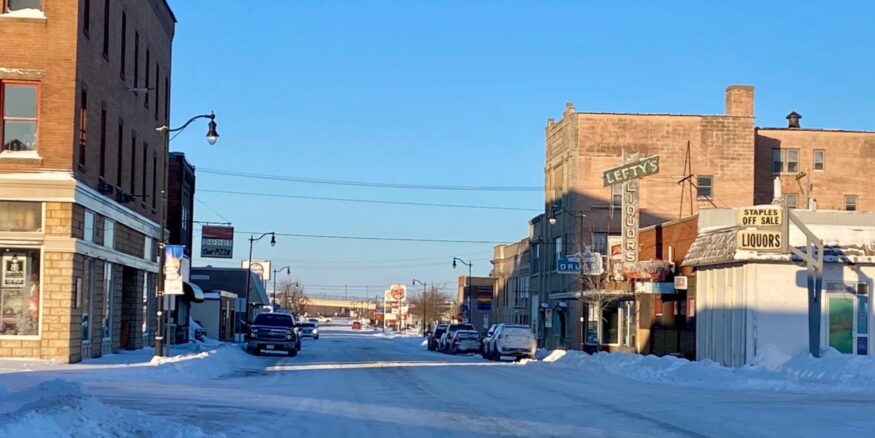
By Marnie Werner, Vice President, Research & Operations
Greater Minnesota can be hard to define for people who don’t live there. Kind of amorphous. And it is hard to come up with a good single name that encompasses what is basically the whole state outside of the seven-county Twin Cities metro. But for us at the Center for Rural Policy & Development, that area isn’t nebulous and vague at all. It contains close to half of Minnesota’s population. We serve 2.6 million people spread across 80 counties and hundreds of communities, each with different needs, hopes, and priorities. We exist to help them—to provide the data, insight, and clarity they need to grow their communities and serve their residents. Data they may not have the time or tools to dig up themselves.
That’s why our work has been and still is about connection. Connecting with communities and their leaders to make sure their voices are heard and that they have the information they need to make decisions that shape their futures. We do this because we’ve seen the difference it makes. Not once has someone come up to me after one of my presentations and said, “Well, that was a waste of time.” In fact, the friendships, collaborations, and community partnerships we’ve built over more than 25 years tell us otherwise. It tells us that what we do is needed.
So, what exactly is Greater Minnesota?
From 30,000 feet, Minnesota might look like a blur of corn and soybean fields to the south and west, pines and lakes to the north. But if you descend a bit—just a few thousand feet—you start to see more.
You see rivers and roads winding through those fields and forests. You see small towns, manufacturing plants, grain silos. Highways with trucks that have names on their sides like Target and HyVee and Walmart. You start to understand that this isn’t a blank canvas—it’s a living landscape.
Drop down lower still, and life comes into focus. A school. A main street. A city hall and fire station under one roof. A VFW with karaoke Friday nights. A new coffee shop that’s becoming a favorite gathering place. Inside, you meet the shop owner who roasts his own beans, serves on the city council and is nervously bracing for the cost of a new water treatment plant in town. His wife works as a nurse in the next town over. Their daughter plays trumpet in the band and runs track.
They’re part of a community. A real one. Not a statistical abstraction. Not just a data point. And this—this town, this family, this story—is one of thousands. Because if you’ve seen one rural town, you’ve seen one rural town. Each has its own history, its own challenges, its own flavor (and maybe even its own coffee shop).
Variety
In a few weeks, I’ll be visiting Pequot Lakes to speak with local leaders and community members about the demographics of their five-county region. I love doing this kind of work. Not just because I enjoy digging into migration patterns and economic trends, but because I get to meet the people who rely on our research—city officials, economic developers, nonprofit leaders, and engaged citizens who are doing the work on the ground.
It’s a good reminder that even though we are one state, Minnesota is deeply varied. It’s 400 miles from top to bottom, nearly 350 miles wide, and more than 84,000 square miles in total. Greater Minnesota alone makes up 96% of that area. And within those 81,000 square miles are distinct regions with unique economies, identities, and ways of life.
We’ve got the Driftless Region’s rolling valleys, the northeast’s mining towns and tall forests, the Red River Valley’s endless flatness, and the green fields and golden prairie of the southwest. Each area contributes something vital. Each deserves to be seen and understood on its own terms.
But here’s the challenge: because more than half of Minnesotans live in the Twin Cities metro—which covers just 3.5% of the state’s land area—statewide data often tells a metro-centric story. For example, Minnesota’s average per-capita earnings in 2023 were a little over $72,000. But most counties outside the metro fall below that—some significantly. In Pine County, it’s only about $46,000.
Those nuances matter. And they’re easy to miss from 30,000 feet. That’s why we come down to ground level.
Years ago, our state demographer and state economist at the time teamed up to write a piece for our first Rural Minnesota Journal describing Minnesota as a collection of “spatially separated neighborhoods”— regions drawn not just for the sake of expedience, but communities bound together by shared demographics and economies. It was a way to rethink how we view the state. A way to get beyond averages and start seeing realities.
Minnesota is 5.8 million people strong. About 3.2 million live in the Twin Cities. That leaves 2.6 million who don’t. But what do we call them? “The rest of the state”? “Non-metro”? Neither does justice to the depth and diversity of Greater Minnesota.
So, we keep showing up. We keep digging into the data. We keep listening, learning, and sharing, because every number represents people. Every trend points to change. And every place—every single place—is worth understanding.
